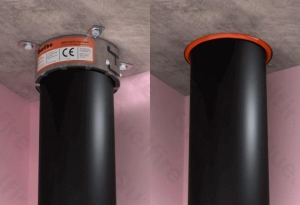Pipe penetration sealing – fire collars or intumescent pipe wraps? Product Information

According to the building regulations ‘Approved Document B’, plastic pipes penetrating fire compartment walls and floors need to be equipped with a firestopping solution to prevent the spread of fire.
Typically, this is covered by installing either intumescent pipe collars or intumescent wraps around the pipes where they go through the fire-rated floors and walls. These systems should be tested to BSEN 1366-3: 2009.
Both intumescent pipe collars (or fire collars) and intumescent pipe wraps work on the same principle; in the event of a fire, when exposed to heat, the intumescent material expands crushing the plastic pipe as it softens and plugs the hole. The fire seal created by the activated intumescent material prevents the fire and smoke spreading to the adjoining compartment.
So, what is the difference between the two products and how to decide which one to use from Quelfire?
Composition
Fire collars consist of a metal shell (typically stainless steel) containing the graphite-based intumescent material. They require mechanical fixings to be secured to the structure. In pipe wraps, the intumescent material is contained within a polythene cover and typically put in place using a self-adhesive tape.
Application
In the event of a fire, it is essential that the intumescent material expands towards the melting plastic pipe so that it exerts enough pressure on the melting pipe to crush it and completely block the hole. In fire collars, the metal shell prevents the intumescent material expanding outwards, making them also suitable to be used where plastic pipes penetrate through plasterboard walls, ceilings, and floors. Due to the lack of the outer band, pipe wraps need to be installed in a solid construction i.e. concrete floors to prevent the intumescent expanding outwards. Some intumescent pipe wraps can also be used in fire batts with the relevant specification. Intumescent wraps can be used where pipes are fitted tightly to the wall and fire collars can’t be installed because of space restrictions.
Ease of installation
While pipe collars are easy to install, with the right design and preparation (by creating the right size hole and using the right materials, like fire protection compound and ablative coated fire batts), pipe wraps are just as simple to put in place. However, if the fire protection is being retro fitted, it is considerably easier to use fire collars as they can also be wrapped around the already installed pipes.
Pipe wraps tend to cost less, however other products may need to be used in conjunction with these. While intumescent wraps may be more cost-effective, applications where fire collars need to be used tend to be more common, so the decision on which product to use is not always evident. If in doubt, always seek for advice from the manufacturer of the system or contact a specialist fire protection professional!
Spotlighting:
If you have any further questions, please don’t hesitate to get in touch at technical@quelfire.co.uk.

